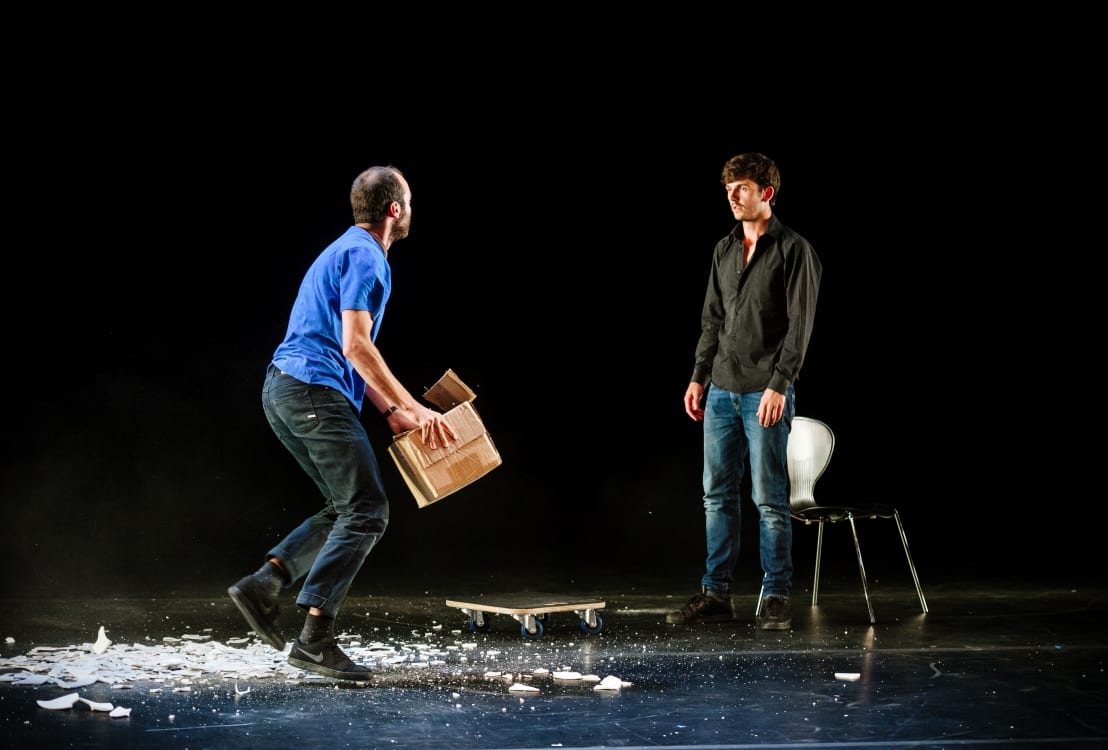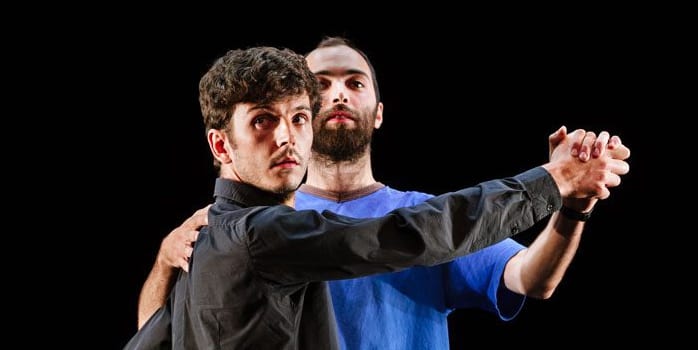Eurohouse and Palmyra is a double-bill of experimental theatre about mounting political and economic tensions in Europe. In the dire areas where society has been severely damaged, namely Greece and Syria, anger and destruction are abundant. These two plays offer dramatic interpretations of strife by following the symbolically antagonistic relationship of Bert and Nasi.
Eurohouse is first up for the evening. It features some good audience interaction organised by Bert and Nasi, where we introduce ourselves to the person next to us and all hold hands to lighten the mood. Bert and Nasi then properly introduce themselves through a series of acrobatic flourishes and choreography set to cloying synth music suggesting their strong friendship. The pair appear initially closely connected, but this is something which quickly falls away. They represent their nationalities respectively: Bert is French and Nasi is Greek, and we see in Nasi a lot of pain and frustration since he personifies the trauma of the devastating Greek debt crisis.

It is soon apparent that Bert is the abuser and Nasi the abusee. Bert imposes himself on Nasi, sometimes psychologically as a playground bully might, but also in more sinister ways, such as through sexual abuse and violence. Bert has a lion’s share of M&Ms and kindly tosses a packet Nasi’s way, but after Nasi scoffs this Bert asks for it to be returned in an obvious analogy to money lending, where French banks made pay-outs to Greece. He gets a bucket for Nasi to throw the sweets up into and the scene, once amicable, now takes a dark turn. I can realise the concept here, but I find these kind of Absurdist vignettes too conceited in their avant-garde abstraction.
Eurohouse is allegorical but not wholly divorced from the real world. There are tie-ins to what is unfurling in contemporary Europe, such as that sweets exchange representing economies, as well as a surreal-sounding dream Bert tries to communicate to the audience being actually a description of the opening of the 2004 Athens Olympics; a boy waving to crowds on a mock-origami boat was part of the introductory parade to the games. When they play footage of this hollow pageant the dream snaps into meaning, and we see how ridiculous that unifying idealistic vision is in context of the modern shambolic situation. There are glints of symbolic success in Eurohouse, but it demands a lot of patience in its meandering and often disturbing abstract episodes about Greece and its French creditors – the obscurity eventually wears thin.

Palmyra is the duo’s latest theatrical endeavour. It is loosely connected to Palmyra and the destruction of relics and the violence that has been perpetrated there by Isis forces. The fourth plinth in Trafalgar Square currently shows a winged bull statue made of syrup cans, which is a reproduction of a now destroyed ancient relic in Mosul, and earlier in Trafalgar Square the Arch of Triumph was recreated in stone to pay homage to the Hellenic architecture of Palmyra. These art pieces decry the abhorrent vandalism in Syria, which is felt as a cultural tragedy as well as a human one, and in the play broken plates are everywhere symbolising this: things are brought into a state of total violation; we get a small window into the sheer brutality of the war.
The message is clearly political, but I question its execution: is the avant-garde the best representation of dire current affairs? I can commend Bert and Nasi for finding a quite striking and arresting way of doing it, but the thing lacks ingenuity for me – this feels derivative of Beckett and it’s not exactly reinventing the theatrical wheel, yet it seems like it lays claim to that. By the end of Palmyra I felt exhausted, since there’s no eloquence or dialogue or subtly to grip onto and explore; the play is cranked up to 11 from the get-go. It’s at best misguided and the worst narcissistic; I can appreciate Palmyra is trying to instil a sense of the fear and chaos of Syrian conflict in its viewers, to frighten us, but it feels effete and trendy more than anything and strains your patience by playing its one note continuously – with all the incessant ranting and raving I found it hard not to roll my eyes after a while. Bert and Nasi are a likeable pair, and I think this is an admirable attempt to create something bizarre and innovative, but for me it doesn’t quite hit the mark.

